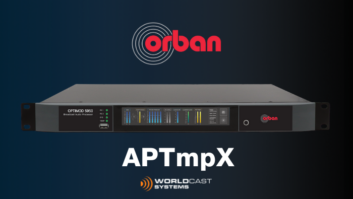(click thumbnail)HILVERSUM, Netherlands The Talpa Radio group is using FMeXtra technology from California-based Digital Radio Express to digitize the FM subcarriers of Radio 538, a popular FM station targeting younger audiences.
Talpa is using the additional capacity of its signal at 102 FM MHz to multicast content of oldies formatted Radio 10 Gold and Hip-Hop station Juize FM.
This is the first broadcaster in the Netherlands to use FMeXtra technology.
“The extra digital signal stream is part of Talpa Radio’s desire to improve and expand its broadcast capacity. And digital broadcasts within the existing FM license could provide the answer to the current shortage in FM frequencies,” said Jan-Willem Brüggenwirth, director of Talpa Radio.
Extra capacity
(click thumbnail)“We want to make optimal use of the frequencies we have,” said Brüggenwirth. “By digitizing our in-house infrastructure and offering all of our signals centralized in a Media Gateway, allowing us to monitor exactly who is taking what content, we now offer our audience three stations in perfect quality,” he said.
The key to the FMeXtra system is the unused capacity available on an analog FM signal. This capacity allows the offering of options like RDS, TMC and extra stations.
“What we do is add an extra data channel alongside these options, and stream it as an AAC+ protocol,” said Alexander Josiassen, head of the Talpa Radio technical department.
(click thumbnail)Jan-Willem Brüggenwirth“Basically,” said Josiassen, “we use the same capacity as the traffic information but supply an audio signal over the available 56 kbps.” The extra capacity carries the Radio 10 Gold and Juize FM signal alongside Radio 538.
Listeners must have a receiver capable of decoding the multicast if they wish to hear the extra stations. Standard receivers still receive the analog signal and listeners will hear no degradation, but they cannot hear the FMeXtra signals.
Netherlands-based Terneuzen equipped the Talpa FM transmitters with the FMeXtra carriers. The company is also offering FMeXtra receivers to consumers.
According to Josiassen, the big advantage of FMeXtra is that the signal uses a station’s existing infrastructure. “As for our studio environment,” he said, “the only thing that had to be done is to include separate protocols for FMeXtra. For instance, you cannot add additional processing to improve sound quality,” he said.
Clear statement
“FMeXtra is a supplemental way of broadcasting. The future will tell whether it will become an alternative for DAB,” said Josiassen.
Unlike the Eureka-147 system, where more transmitters are necessary to cover the territory, the FMeXtra system uses a station’s existing analog transmitter network to get optimal coverage, according to Josiassen.
With the auction for DAB frequencies planned for later this year, the commercial radio market is now eyeing possible alternatives.
In a next step, Talpa Radio wants to set up a distribution deal to supply the necessary receivers to the public. “The AAC radios are available in the Benelux,” said Josiassen, referring to the economic union in Western Europe that includes neighboring monarchies Belgium, the Netherlands and Luxembourg.
“But we want to team up with a number of manufacturers like Terratec to distribute our own brand of FMeXtra receivers. Our plans are to get them in the shops this fall.”
Talpa wants to play a role in the distribution of the AAC radios in shops, supermarkets and entertainment stores, both in the Netherlands and abroad, backed by a campaign to promote its brand of receivers.















